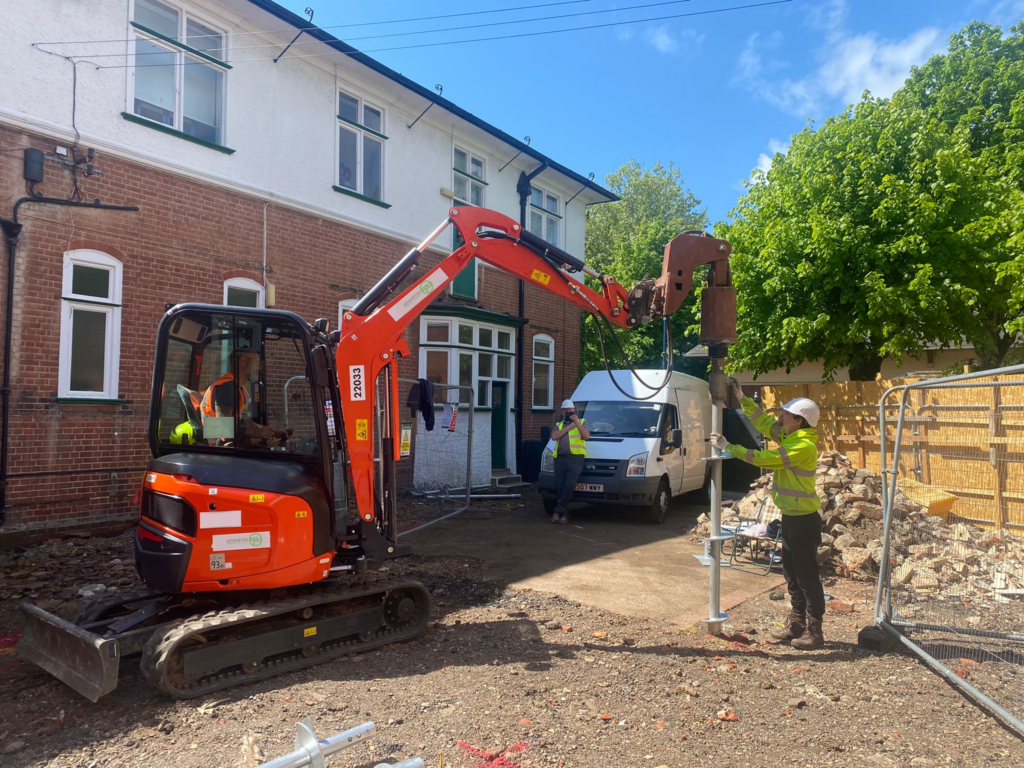
Screw piling, also known as helical piling or helical screw foundations, is a type of deep foundation system used to support structures of various sizes — from garden buildings to bridges and multi-storey buildings.
Unlike traditional concrete footings, screw piles don’t require excavation, curing time, or large-scale groundwork. The system is quick to install, highly adaptable to ground conditions, and causes minimal disturbance to the surrounding area.
This blog will explain what screw piling is, how it works, where it’s used, and why it’s become such a popular alternative to concrete foundations across the UK.
Each screw pile consists of a steel shaft — often circular hollow section — with one or more helix plates welded near the base. These plates act like a thread, allowing the pile to be “screwed” into the soil.
As the pile is rotated and pushed down, it cuts into the ground, displacing minimal material. The torque required to install the pile can also be measured to estimate load-bearing capacity in real time — a huge benefit for engineering validation.
Once installed to the required depth, the pile remains in place and supports vertical and lateral loads from the structure above.
No concrete required
Fast installation
All-weather capability
Real-time load verification
Minimal spoil or excavation
Lower environmental impact
Screw piling offers a modern alternative to traditional foundations by removing the need for concrete and reducing the time spent on site.
Installations are quick, clean, and can proceed in a range of weather conditions. Each pile is load-tested as it’s installed, providing immediate structural feedback without extra testing.
With minimal ground disturbance and a much smaller carbon footprint than concrete foundations, screw piling is both practical and sustainable — particularly suited to restricted access sites or time-sensitive projects.
Screw piles are versatile and can be used across a broad range of construction projects, including:
Screw piling solutions generally save you hue costs on all the preliminaries for your project.
Both full-size and mini screw piles are available to suit various structural loads and site access constraints.
| Feature | Screw Piling | Concrete Foundations |
|---|---|---|
| Installation Time | Same-day installation | Several days including curing |
| Ground Impact | Low | High (excavation, waste) |
| Weather Dependency | All-weather | Limited by wet and cold conditions |
| Load Testing | Real-time torque readings | Requires site testing after pour |
| Environmental Impact | Low CO₂, less material usage | High CO₂ from concrete production |
| Removal/Reusability | Can be removed and reused | Not possible once poured |
Screw piling isn’t just quicker — it’s smarter. It reduces labour, minimises ground disruption, and allows for greater precision.
Screw piles come in various sizes and designs. The most common types include:
Full-Size Screw Piles
Used for high-load structural projects such as multi-storey buildings, commercial installations, and bridge supports.
Mini Screw Piles
A scaled-down version used for lighter structures like garden buildings, conservatories, and solar frames. These offer a structural-grade alternative to basic ground screws.
If you’re planning a structure where:
The ground conditions are varied
Access for concrete deliveries is difficult
Fast turnaround is required
Environmental or tree root impact needs to be minimised
A clean, engineered foundation is needed
…then screw piling could be the ideal solution.
A professional installer will carry out a site investigation and calculate the number, type, and depth of piles required to safely carry your building’s load.
Do screw piles work in clay or sandy soil?
Yes. Screw piles are effective in a wide range of soil types. Their helical design helps them grip through soft or loose material to reach bearing strata.
Can screw piles be used for sloped sites?
Absolutely. They’re ideal for sloping ground and embankments, where traditional formwork would be costly and slow.
How deep do screw piles go?
Depth depends on ground conditions and structural requirements. Typical installations range from 1.5 to 6 metres deep.
Are screw piles permanent?
Yes. They are a fully structural, permanent solution — though they can also be removed in the future if required.
How much do screw piles cost?
Costs vary by project, but installation is often more cost-effective than traditional footings once time, labour, and material savings are factored in.
Screw piling has grown rapidly in popularity across the UK for good reason. It’s fast, clean, accurate, and adaptable — whether you’re building a conservatory, installing solar panels, or developing infrastructure.
At USP, we supply and install both full-size and mini screw piles across residential, commercial, and specialist sectors.
We carry out full ground assessments and provide engineered solutions designed to suit your site and structure.
Need expert advice?
Get in touch with the team at USP to discuss your project and receive a tailored screw piling solution.

Our team of experts will be happy to help you with any questions you may have, and to provide you with a free, no-obligation quote for your project.
